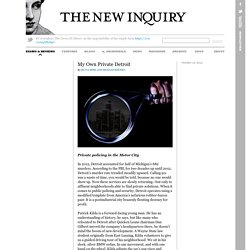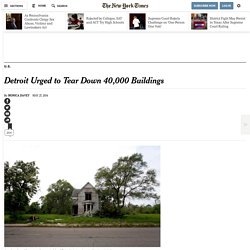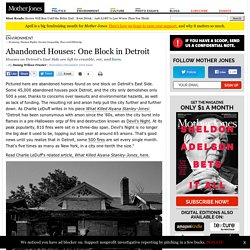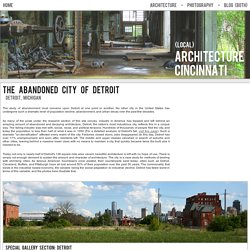

Alondra
Detroit’s Bankruptcy Reflects a History of Racism. This is black history month. My Own Private Detroit. Private policing in the Motor City In 2012, Detroit accounted for half of Michigan’s 682 murders.

According to the FBI, for two decades up until 2012, Detroit’s murder rate trended steadily upward. Calling 911 was a waste of time, you would be told, because no one would show up. Now these services are slowly returning—but only to affluent neighborhoods able to find private solutions. When it comes to public policing and security, Detroit operates using a modified template from America’s nefarious robber-baron past: It is a postindustrial city brazenly flouting decency for profit. Patrick Kilda is a forward-facing young man. “Since I’ve been here, it’s been gentrified a lot. Visit Detroit at your own risk, police union warns. By NBC News staff The Detroit Police Officers Association is warning citizens and out-of-towners that they enter Detroit at their own risk, saying that the "grossly understaffed" and overworked police force cannot adequately protect the public in the increasingly violent city.

“Detroit is America’s most violent city, its homicide rate is the highest in the country and yet the Detroit Police Department is grossly understaffed,” DPOA Attorney Donato Iorio told WWJ over the weekend. “The DPOA believes that there is a war in Detroit, but there should be a war on crime, not a war on its officers.” The most dangerous cities in America An analysis of the FBI's Uniform Crime Report data from 24/7 Wall St. To Do. How to: Survive a trip to Detroit. Inside Look at the Detroit Fire Department and its Firefighters. Volume of abandoned homes 'absolutely terrifying'
Detroit — Detroit has had more homes foreclosed in the past 10 years than the total number of houses in several suburbs — or all of Buffalo, New York.

Since 2005, more than 1-in-3 Detroit properties — 139,699 of 384,672 — have been foreclosed because of mortgage defaults or unpaid taxes, property records show. The vast majority are houses, and the tally is so huge it shocked even those who spent years working on foreclosure in Detroit. "When you see it on a map, it's absolutely terrifying," said Chris Uhl, a vice president of the Skillman Foundation that is working to prevent foreclosures. Housing crisis accelerates blight in Detroit neighborhoods. By Debra Watson and Anne Moore 21 October 2008.

Marilyn Salenger: ‘White flight’ and Detroit’s decline. By Marilyn Salenger By Marilyn Salenger July 21, 2013 Marilyn Salenger is president of Strategic Communications Services and a former correspondent and news anchor for several CBS stations.

An almost palpable sadness has swept across the country at the news that the city of Detroit has filed for bankruptcy. While the possibility of this had been discussed, the reality of what was once the fourth-largest city in the United States sinking to such depths is disheartening, a moment people will remember for years to come. To understand that the decline and bankruptcy represent so much more than dollars and cents requires a step back to a time that many would prefer to forget but remains unforgettable. Detroit Urged to Tear Down 40,000 Buildings. “Detroit needs to act aggressively to eradicate the blight in as fast a time as possible,” the report concluded, noting that the city needed to move faster than any other city contending with a high level of decay to keep matters from growing even worse.

City leaders call for ending blight in the city’s residential neighborhoods in five years, while acknowledging that dealing with big empty industrial buildings — some 559 of them — could take longer. “These structures are unique because of their larger size and their potential for greater environmental issues than other structures,” the report said, noting that the cost of demolishing just a single large industrial building can run into the tens of millions of dollars. OPEN Map “Without a solution,” the report said, “they will continue to exert a downward pull on any efforts to restore the neighborhoods in which they are located, and as well as on the city as a whole.”
Kevyn D. Still, the challenges ahead are enormous. OPEN Document Mr. Abandoned Houses: One Block in Detroit. Pictured here are abandoned homes found on one block on Detroit's East Side.

Some 45,000 abandoned houses pock Detroit, and the city only demolishes only 500 a year, thanks to concerns over lawsuits and environmental hazards, as well as lack of funding. The resulting rot and arson help pull the city further and further down. As Charlie LeDuff writes in his piece What Killed Aiyana Stanley-Jones: "Detroit has been synonymous with arson since the '80s, when the city burst into flames in a pre-Halloween orgy of fire and destruction known as Devil's Night. At its peak popularity, 810 fires were set in a three-day span. Devil's Night is no longer the big deal it used to be, topping out last year at around 65 arsons.
Read Charlie LeDuff's related article, What Killed Aiyana Stanley-Jones, here. The Abandoned City of Detroit - Photography: Zach Fein. The study of abandonment must convene upon Detroit at one point or another.

No other city in the United States has undergone such a dramatic level of population decline, abandonment, and urban decay over the past few decades. As many of the posts under the research section of this site convey, industry in America has toppled and left behind an amazing amount of abandoned and decaying architecture. Whose Neighborhood Is It? Photo On June 25, 1974, suburban residents of Detroit won their four-year battle to overturn court-ordered busing of black city students across county lines into their schools.

In a key 5-4 Supreme Court decision, Milliken v. Bradley, Chief Justice Warren Burger declared that 41 white suburban governments had not committed “significant violations” of the Constitution. Burger wrote: No single tradition in public education is more deeply rooted than local control over the operation of public schools; local autonomy has long been thought essential both to the maintenance of community concern and support for public schools and to quality of the educational process. The victory in Milliken was based on the assumption that African-Americans would be bused in, not that they would be living next door.
Southfield, Mich., for example, which had been 0.7 percent black in 1970, by 2010 had become 70.3 percent black, and its schools nearly 95 percent black.